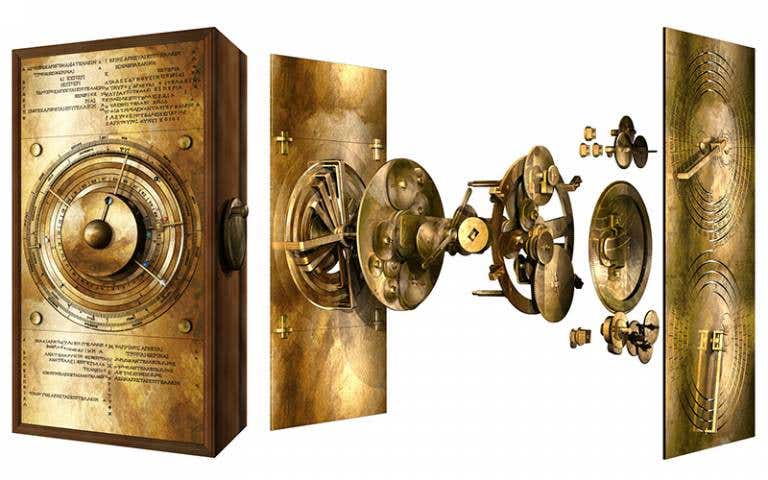This incredible 2,000-year-old device is the world’s first computer
The Antikythera Mechanism, a 2,000-year-old astronomical calculator, holds the title of the world’s earliest known analog computer.

The Antikythera Mechanism, a 2,000-year-old astronomical calculator, holds the title of the world's earliest known analog computer.
A new study by the UCL Antikythera Research Team, published in Scientific Reports, sheds light on a previously enigmatic aspect of the device – the display of the ancient Greek conception of the Universe (Cosmos).
"Our model," explains Professor Tony Freeth, lead author and UCL Mechanical Engineering expert, "is the first to simultaneously adhere to the physical evidence, the gearing system's complexity, and the descriptions inscribed on the Mechanism itself. This represents a remarkable feat of ancient Greek engineering, showcasing the Sun, Moon, and planets in a captivating display."
Discovered in 1901 by Greek sponge divers near Antikythera, a small Mediterranean island, the Antikythera Mechanism has captivated and perplexed researchers for over a century. This intricate bronze device, comprised of 30 surviving gears, boasts functionalities that include predicting astronomical phenomena like eclipses, lunar phases, planetary positions, and even the dates of the Olympics.
Significant progress has been made in deciphering the Mechanism's inner workings over the past century. 3D X-ray and surface imaging advancements in 2005 allowed researchers to understand how the device predicted eclipses and accounted for the Moon's variable motion. However, the intricate gearing system at the front remained a persistent enigma.
The significant challenge lies in the fragmentary nature of the Mechanism. Only about a third has survived, scattered across 82 fragments. Fragment A, the largest piece, showcases features like bearings, pillars, and a block. Fragment D contains an unexplained disk, a 63-tooth gear, and a plate.
Related Stories
Previous studies, utilizing 2005 X-ray data, revealed thousands of hidden text characters within the fragments, unread for nearly two millennia. Inscriptions on the back cover described a Cosmos display featuring planets moving on rings indicated by marker beads. This display formed the basis for the team's reconstruction efforts.
Crucially, the X-rays of the front cover revealed two key numbers: 462 years and 442 years. These numbers precisely represent the cyclical motions of Venus and Saturn, respectively, as observed from Earth. These planets exhibit periods where their movements appear to reverse against the backdrop of stars. Predicting their positions necessitates tracking these variable cycles over extended durations.
"The foundational astronomy of the first millennium BC originated in Babylonia," explains PhD candidate Aris Dacanalis, a member of the UCL Antikythera Research Team. "However, none of this knowledge offered insights into how the ancient Greeks arrived at the remarkably accurate 462-year cycle for Venus and the 442-year cycle for Saturn."
Employing an ancient Greek mathematical method attributed to the philosopher Parmenides, the UCL team not only explained the derivation of the Venus and Saturn cycles but also successfully reconstructed the cycles for other planets, even where evidence was lacking.
"Following significant effort," elaborates PhD candidate David Higgon, another team member, "we were able to reconcile the evidence from Fragments A and D with a mechanism for Venus that precisely models its 462-year planetary period relation, with the 63-tooth gear playing a pivotal role."
Professor Freeth adds, "The team then devised innovative mechanisms for all the planets, capable of calculating the newly discovered, more advanced astronomical cycles. This design minimized the total number of gears required, ensuring they would fit within the limited space available."
"This discovery represents a significant theoretical leap in comprehending how the Cosmos display functioned within the Mechanism," emphasizes co-author Dr. Adam Wojcik (UCL Mechanical Engineering). "The next step involves validating its feasibility by constructing the display using techniques employed in antiquity. A particular challenge will be replicating the system of nested tubes that conveyed the astronomical outputs."
This breakthrough brings researchers a step closer to fully understanding the Antikythera Mechanism's capabilities and the precision of its astronomical predictions. The original device is currently housed in the National Archaeological Museum in Athens.
Note: Materials provided above by The Brighter Side of News. Content may be edited for style and length.
Like these kind of feel good stories? Get the Brighter Side of News' newsletter.
Joseph Shavit
Head Science News Writer | Communicating Innovation & Discovery
Based in Los Angeles, Joseph Shavit is an accomplished science journalist, head science news writer and co-founder at The Brighter Side of News, where he translates cutting-edge discoveries into compelling stories for a broad audience. With a strong background spanning science, business, product management, media leadership, and entrepreneurship, Joseph brings a unique perspective to science communication. His expertise allows him to uncover the intersection of technological advancements and market potential, shedding light on how groundbreaking research evolves into transformative products and industries.



